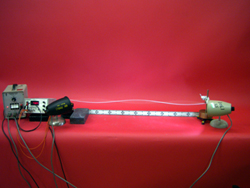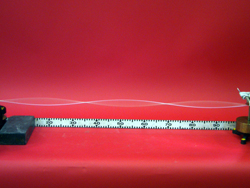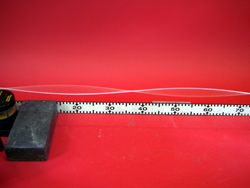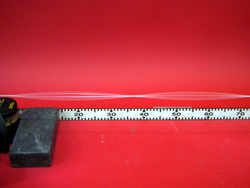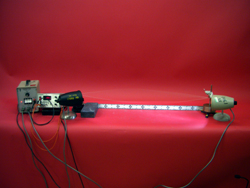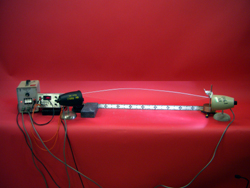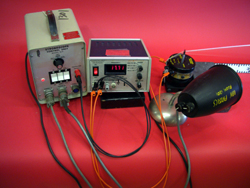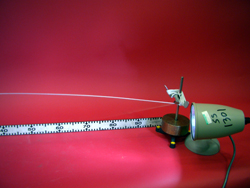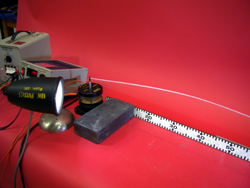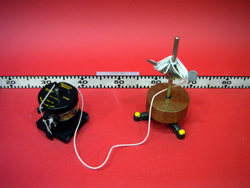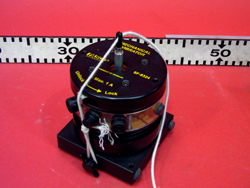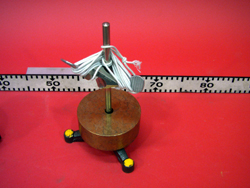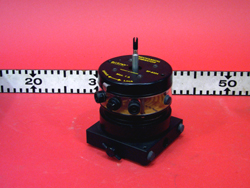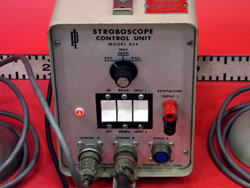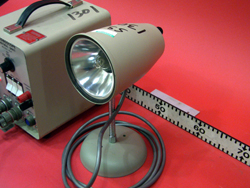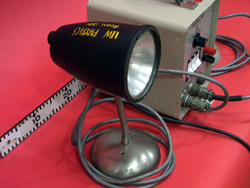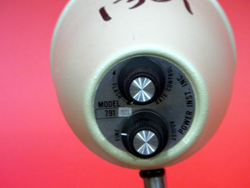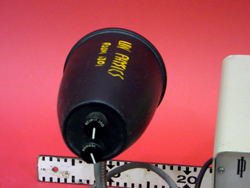|
Size: 4930
Comment: converted to 1.6 markup
|
← Revision 31 as of 2018-07-18 18:47:42 ⇥
Size: 5153
Comment:
|
| Deletions are marked like this. | Additions are marked like this. |
| Line 2: | Line 2: |
| ||<:30%>[[PiraScheme#WavesSound| Table of Waves and Sound Demonstration]]||<:30%>[[WSEquipmentList| Wave and Sound Equipment List]]||<:30%>[[Demonstrations|Lecture Demonstrations]]|| | ||<30% style="text-align:center">[[PiraScheme#WavesSound|Table of Waves and Sound Demonstration]] ||<30% style="text-align:center">[[WSEquipmentList|Wave and Sound Equipment List]] ||<30% style="text-align:center">[[Demonstrations|Lecture Demonstrations]] || |
| Line 5: | Line 6: |
| '''Topic and Concept:''' | |
| Line 6: | Line 8: |
| '''Topic and Concept:''' Wave Motion, [[WaveMotion#StandingWaves| 3B22. Standing Waves]] |
. Wave Motion, [[WaveMotion#StandingWaves|3B22. Standing Waves]] '''pira200 Listed''' |
| Line 10: | Line 13: |
| * '''Cabinet:''' [[WavesSoundCabinet| Waves and Sound]] (WS) | * '''Cabinet:''' [[WavesSoundCabinet|Waves and Sound]] (WS) |
| Line 19: | Line 23: |
| ||<40% style="" ;text-align:center">'''Equipment''' ||<30% style="text-align:center">'''Location''' ||<25% style="text-align:center">'''ID Number''' || || || || || ||Pasco Mechanical Vibrator ||[[WSCabinetRtBayA4|WS, Bay A4 Right, Shelf #1]] || || ||Ring Stand with Elastic Cord ||[[WSCabinetRtBayA4|WS, Bay A4 Right, Shelf #1]] || || ||Strobe Lights ||[[WSCabinetRtBayB1|WS Bay B1 Left, Shelf #2]] || || ||Function Generator ||[[EMCabinetLtBayB1|EM, Bay B1, Shelf #3]] || || ||Lead Brick ||Rod and Clamp Cabinet (near main lecture halls) || || ||Extra Elastic Cord ||[[WSCabinetRtBayA3|WS, Bay A3, Shelf #3]] || || |
|
| Line 20: | Line 32: |
| ||<:style="width: 60%" :40%>'''Equipment'''||<:30%>'''Location'''||<:25%>'''ID Number'''|| || || || || ||Pasco Mechanical Vibrator||[[WSCabinetRtBayA4| WS, Bay A4 Right, Shelf #1]]|| || ||Ring Stand with Elastic Cord||[[WSCabinetRtBayA4| WS, Bay A4 Right, Shelf #1]]|| || ||Strobe Lights||[[WSCabinetRtBayB1| WS Bay B1 Left, Shelf #2]]|| || ||Function Generator||[[EMCabinetLtBayB1|EM, Bay B1, Shelf #3]]|| || ||Lead Brick||Rod and Clamp Cabinet (near main lecture halls)|| || ||Extra Elastic Cord||[[WSCabinetRtBayA3|WS, Bay A3, Shelf #3]]|| || |
|
| Line 30: | Line 36: |
| Line 32: | Line 39: |
| '''Setup and Demonstration:''' | '''Setup and Demonstration:''' |
| Line 34: | Line 41: |
| 1. Take the small ring stand with the elastic cord wrapped around it. Unwrap enough cord to stretch the cord across the lecture bench. 1. With the Pasco vibrator, take the looped end of the cord, string in through the forked tip, and attach to the base set screw that is typically used to hold rods. This will anchor the cord. |
1. Take the small ring stand with the elastic cord wrapped around it. Unwrap enough cord to stretch the cord across the lecture bench. 1. With the Pasco vibrator, take the looped end of the cord, string in through the forked tip, and attach to the base set screw that is typically used to hold rods. This will anchor the cord. |
| Line 40: | Line 47: |
| 1. Use the strobe lights to make the vibrating cord stand still or make it roll in slow motion. The strobe speed can be adjusted on the back of the lamp. | 1. Use the strobe lights to make the vibrating cord stand still or make it roll in slow motion. The strobe speed can be adjusted on the back of the lamp. |
| Line 43: | Line 50: |
| Line 45: | Line 53: |
'''Demonstration:''' |
'''Demonstration:''' |
| Line 58: | Line 65: |
| λ*f = v | λ*f = v |
| Line 64: | Line 71: |
since it's difficult to attain the same the tension and length of the cord, the fundamental frequency will differ every time this demonstration is set up. |
since it's difficult to attain the same the tension and length of the cord, the fundamental frequency will differ every time this demonstration is set up. |
| Line 70: | Line 76: |
| || {{attachment:MeldesString02-250.jpg}} || {{attachment:MeldesString03-250.jpg}} || {{attachment:MeldesString04-250.jpg}} || {{attachment:MeldesString05-250.jpg}} || || {{attachment:MeldesString06-250.jpg}} || {{attachment:MeldesString07-250.jpg}} || {{attachment:MeldesString08-250.jpg}} || {{attachment:MeldesString09-250.jpg}} || || {{attachment:MeldesString10-250.jpg}} || {{attachment:MeldesString11-250.jpg}} || {{attachment:MeldesString12-250.jpg}} || {{attachment:MeldesString13-250.jpg}} || || {{attachment:MeldesString14-250.jpg}} || {{attachment:MeldesString15-250.jpg}} || {{attachment:MeldesString16-250.jpg}} || {{attachment:MeldesString17-250.jpg}} || || {{attachment:MeldesString18-250.jpg}} || {{attachment:MeldesString19-250.jpg}} || {{attachment:MeldesString20-250.jpg}} || {{attachment:MeldesString21-250.jpg}} || |
|
| Line 71: | Line 82: |
| ||{{attachment:MeldesString02-250.jpg}}||{{attachment:MeldesString03-250.jpg}}||{{attachment:MeldesString04-250.jpg}}||{{attachment:MeldesString05-250.jpg}}|| ||{{attachment:MeldesString06-250.jpg}}||{{attachment:MeldesString07-250.jpg}}||{{attachment:MeldesString08-250.jpg}}||{{attachment:MeldesString09-250.jpg}}|| ||{{attachment:MeldesString10-250.jpg}}||{{attachment:MeldesString11-250.jpg}}||{{attachment:MeldesString12-250.jpg}}||{{attachment:MeldesString13-250.jpg}}|| ||{{attachment:MeldesString14-250.jpg}}||{{attachment:MeldesString15-250.jpg}}||{{attachment:MeldesString16-250.jpg}}||{{attachment:MeldesString17-250.jpg}}|| ||{{attachment:MeldesString18-250.jpg}}||{{attachment:MeldesString19-250.jpg}}||{{attachment:MeldesString20-250.jpg}}||{{attachment:MeldesString21-250.jpg}}|| |
|
| Line 78: | Line 86: |
| Line 82: | Line 91: |
| * [[https://en.wikipedia.org/wiki/Melde%27s_experiment|Wikipedia - Melde's Experiment]] | * [[https://en.wikipedia.org/wiki/Melde's_experiment|Wikipedia - Melde's Experiment]] |
Melde's Vibrating String, 3B22.10
Topic and Concept:
Wave Motion, 3B22. Standing Waves
pira200 Listed
Location:
Cabinet: Waves and Sound (WS)
Bay: (A4 Right)
Shelf: #1
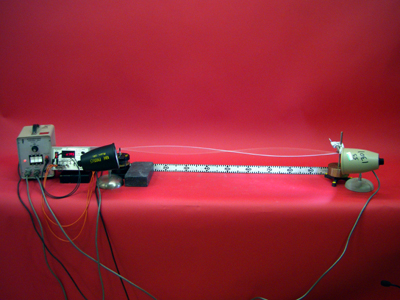
Description:
The Pasco driver controlled by a function generator vibrates an elastic cord. By varying the driving frequency and amplitude, one can produce standing waves. The nodes and the antinodes can be seen better by using strobe lights.
Equipment |
Location |
ID Number |
|
|
|
Pasco Mechanical Vibrator |
|
|
Ring Stand with Elastic Cord |
|
|
Strobe Lights |
|
|
Function Generator |
|
|
Lead Brick |
Rod and Clamp Cabinet (near main lecture halls) |
|
Extra Elastic Cord |
|
Important Setup Notes:
- N/A
Setup and Demonstration:
- Take the small ring stand with the elastic cord wrapped around it. Unwrap enough cord to stretch the cord across the lecture bench.
- With the Pasco vibrator, take the looped end of the cord, string in through the forked tip, and attach to the base set screw that is typically used to hold rods. This will anchor the cord.
- Place a lead brick in front of the vibrator to prevent the cord from pulling or tipping the the vibrator.
- Place the strobe at each end of the cord in such a way that the strobe light are aimed at the cord and NOT at the students.
- Set the function generator so that the cord vibrates at it's fundamental frequency.
- Vary the driving frequency and amplitude to show the other modes of a standing wave fixed at both ends. Be sure to point out the nodes and the antinodes.
- Use the strobe lights to make the vibrating cord stand still or make it roll in slow motion. The strobe speed can be adjusted on the back of the lamp.
Cautions, Warnings, or Safety Concerns:
- Strobe lights can bother students with epilepsy. This warning should be stated in class before doing the demonstration.
Demonstration:
The fundamental frequency of a wave on a string depends on the speed of wave propagation and the length of the string. The speed of propagation on the string depends on the string tension and the linear mass density as follows
v = Sqrt[T / ρ].
The boundary conditions determine our wavelength. For a string with fixed ends, the wavelength must be an integer multiple of half the length of the string
λn = 2*L/n.
Since wavelength and frequency of oscillations of a wave are related to the wave speed by
λ*f = v
we can find that the fundamental (lowest order) frequency is given by
f1 = v/λ1 = Sqrt(T/ ρ) / (2*L)
since it's difficult to attain the same the tension and length of the cord, the fundamental frequency will differ every time this demonstration is set up.
Higher order frequencies can be achieved by increasing the frequency of oscillations (done using the function generator) having the form
fn = v/λn = n * Sqrt(T/ ρ) / (2*L)
|
|
|
|
|
|
|
|
|
|
|
|
|
|
|
|
|
|
|
|
Videos:
References:
